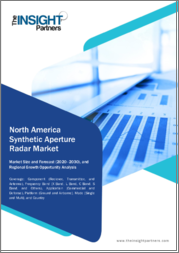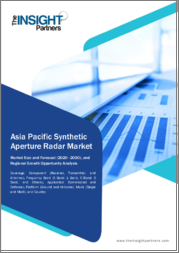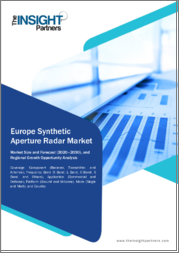
|
시장보고서
상품코드
1722620
합성 개구 레이더 시장 보고서 : 구성요소, 모드, 주파수 대역, 플랫폼, 용도, 지역별(2025-2033년)Synthetic Aperture Radar Market Report by Component, Mode, Frequency Band, Platform, Application, and Region 2025-2033 |
||||||
세계 합성 개구 레이더 시장 규모는 2024년 46억 달러에 달했습니다. 향후 IMARC Group은 2033년까지 시장 규모가 103억 달러에 달할 것으로 예상하며, 2025년부터 2033년까지 8.88%의 연평균 성장률(CAGR)을 기록할 것으로 전망하고 있습니다. 지구 관측 및 원격 감지 기능에 대한 수요 증가, 농업 및 광업과 같은 상업 분야에서 SAR 시스템의 광범위한 채택, 지정학적 긴장과 안보 우려의 증가 등이 시장 성장을 촉진하는 요인으로 작용하고 있습니다.
합성 개구 레이더(SAR)는 국방 및 재난 관리를 위한 지구 관측과 환경 감시를 용이하게 하는 원격탐사 기술입니다. 지표면을 향해 마이크로파 신호를 발사하고, 반사된 신호를 포착하여 고해상도 이미지를 생성합니다. 기상 조건이나 일조 시간에 관계없이 이미지를 생성할 수 있습니다. 마이크로파 주파수에 의존하기 때문에 구름, 비, 어둠을 투과할 수 있습니다. 지표면의 고도를 측정할 수 있어 지형 매핑 및 지형 분석에 적합합니다. 또한 작물 모니터링, 토양 수분 추정, 수확량 예측에도 도움이 됩니다.
농업 및 광업과 같은 상업 분야에서 SAR 시스템이 널리 채택되고 있는 것은 좋은 시장 전망을 가져오고 있습니다. 또한, 토지 측량 및 구조물 모니터링과 같은 다양한 목적으로 건설 산업에서 SAR 기술의 사용이 증가하고 있는 것도 시장에 긍정적인 영향을 미치고 있습니다. 이와는 별도로 우주 기술, 특히 소형 위성 별자리 기술에 대한 투자 증가는 시장 성장을 강화하고 있습니다. 또한, 고해상도 지구 관측 데이터를 생성하기 위해 비용 효율적인 소형 위성에서 SAR 시스템의 사용이 증가하고 있는 것도 시장 성장을 촉진하고 있습니다. 또한, SAR 기술과 사물인터넷(IoT)의 통합은 재난 관리를 위한 실시간 모니터링 기능을 강화하여 SAR 시스템의 범용성을 높이고 있습니다.
합성 개구 레이더 시장 동향 및 촉진요인:
지구 관측 및 원격탐사 수요 증가
지구 관측 및 원격 감지 기능에 대한 수요 증가는 시장에 긍정적인 영향을 미치는 주요 요인 중 하나이며, SAR 기술은 전천후, 주야간 촬영이라는 고유한 이점을 제공하여 환경 변화 모니터링, 재난 관리 및 방위 용도에 유용하게 사용됩니다. 또한, 기후 변화와 자연 재해의 빈발에 대한 우려가 높아지면서 시장 성장에 힘을 실어주고 있습니다. 이와는 별도로, 전 세계 정부 당국과 조직은 이러한 문제를 모니터링하고 대응할 수 있는 능력을 강화하기 위해 SAR 시스템에 투자하고 있습니다. 또한, 지표면의 고해상도 3차원(3D) 이미지를 캡처할 수 있기 때문에 농업, 임업, 도시 계획에서 SAR이 널리 사용되고 있는 것도 시장 전망을 밝게 하고 있습니다.
레이더 시스템의 기술적 진보
레이더 시스템의 지속적인 발전은 시장 성장을 촉진하는 주요 요인 중 하나입니다. 이러한 기술 혁신에는 더 작고 비용 효율적인 SAR 센서의 개발, 소형 위성용 SAR 페이로드의 소형화, 이미지 처리 알고리즘의 개선 등이 포함됩니다. 이와는 별도로, SAR에 대한 쉬운 접근성은 소규모 정부, 연구 기관, 상업 단체를 포함한 다양한 분야에서 SAR의 채택을 촉진하고 있습니다. 또한, SAR 데이터 수집 및 처리 비용이 감소함에 따라 스타트업과 기업가들이 시장에 진입하여 혁신적인 애플리케이션을 개발할 수 있는 좋은 기회가 되고 있습니다. 또한, SAR과 광학 센서 및 적외선 센서와 같은 다른 원격 감지 기술과의 통합은 하이브리드 시스템의 기능을 강화하여 시장 성장을 더욱 촉진하고 있습니다.
정부 이니셔티브와 민관 파트너십
지정학적 긴장이 고조되고 안보 우려가 높아지면서 국방 및 정보 애플리케이션에서 SAR에 대한 수요가 증가하고 있습니다. 또한, 점점 더 많은 국가들이 원격지 및 기밀 지역에서의 활동을 감시하기 위한 SAR의 전략적 중요성을 인식하고 있습니다. 이와는 별도로 선박, 항공기, 지상 차량과 같은 이동체를 탐지하고 추적하는 SAR의 능력에 대한 인식이 높아지면서 국경 보안, 해상 감시, 정찰 임무에 대한 적용이 확대되고 있습니다. 또한, 많은 국가들이 보안 및 감시 역량 강화에 주력하고 있으며, SAR 시스템 및 관련 인프라에 지속적으로 투자하고 있습니다. 또한, 국제적인 협력과 파트너십을 통해 공동 위성 별자리 및 데이터 공유 협정이 개발되고 있습니다.
목차
제1장 서문
제2장 조사 범위와 조사 방법
- 조사 목적
- 이해관계자
- 데이터 소스
- 1차 정보
- 2차 정보
- 시장 추정
- 상향식 접근
- 하향식 접근
- 조사 방법
제3장 주요 요약
제4장 소개
- 개요
- 주요 업계 동향
제5장 세계의 합성 개구 레이더 시장
- 시장 개요
- 시장 실적
- COVID-19의 영향
- 시장 예측
제6장 시장 내역 : 구성요소별
- 안테나
- 수신기
- 송신기
제7장 시장 내역 : 모드별
- 싱글 모드
- 멀티 모드
제8장 시장 내역 : 주파수 대역별
- X 밴드
- L 밴드
- C 밴드
- S 밴드
- K, Ku, Ka 밴드
- VHF/UHF 밴드
- 기타
제9장 시장 내역 : 플랫폼별
- 항공
- 육상
제10장 시장 내역 : 용도별
- 방위
- 상업
제11장 시장 내역 : 지역별
- 북미
- 미국
- 캐나다
- 아시아태평양
- 중국
- 일본
- 인도
- 한국
- 호주
- 인도네시아
- 기타
- 유럽
- 독일
- 프랑스
- 영국
- 이탈리아
- 스페인
- 러시아
- 기타
- 라틴아메리카
- 브라질
- 멕시코
- 기타
- 중동 및 아프리카
- 시장 내역 : 국가별
제12장 SWOT 분석
- 개요
- 강점
- 약점
- 기회
- 위협
제13장 밸류체인 분석
제14장 Porter's Five Forces 분석
- 개요
- 구매자의 교섭력
- 공급 기업의 교섭력
- 경쟁 정도
- 신규 참여업체의 위협
- 대체품의 위협
제15장 가격 분석
제16장 경쟁 구도
- 시장 구조
- 주요 기업
- 주요 기업 개요
- Airbus SE
- Aselsan A.
- BAE Systems plc
- Cobham Limited
- General Atomics
- Israel Aerospace Industries
- L3Harris Technologies Inc.
- Leonardo S.p.A.
- Lockheed Martin Corporation
- Northrop Grumman Corporation
- Raytheon Technologies Corporation
- Saab AB
- Thales Group
The global synthetic aperture radar market size reached USD 4.6 Billion in 2024. Looking forward, IMARC Group expects the market to reach USD 10.3 Billion by 2033, exhibiting a growth rate (CAGR) of 8.88% during 2025-2033. The escalating demand for Earth observation and remote sensing capabilities, widespread adoption of SAR systems in commercial sectors like agriculture and mining, and rising geopolitical tensions and security concerns are some of the factors propelling the market growth.
Synthetic aperture radar (SAR) is a remote sensing technology that facilitates earth observation and environmental monitoring for defense and disaster management. It operates by emitting microwave signals towards the surface of the earth and capturing the reflected signals to create high-resolution images. It can produce images regardless of weather conditions or daylight. It relies on microwave frequencies, allowing it to penetrate clouds, rain, and darkness. It can determine the elevation of surface features, making it ideal for topographic mapping and terrain analysis. It also assists in crop monitoring, soil moisture estimation, and yield prediction.
The widespread adoption of SAR systems in commercial sectors like agriculture and mining is offering a favorable market outlook. Additionally, the rising utilization of SAR technology in the construction industry for various purposes, such as land surveying and structural monitoring, is positively influencing the market. Apart from this, increasing investments in space technologies, especially small satellite constellations are strengthening the growth of the market. Furthermore, the rising use of SAR systems in small, cost-effective satellites to generate high-resolution earth observation data is augmenting the market growth. Moreover, the integration of SAR technology with the Internet of Things (IoT) is offering enhanced real-time monitoring capabilities for disaster management and making SAR systems more versatile.
Synthetic Aperture Radar Market Trends/Drivers:
Increasing demand for earth observation and remote sensing
The rising demand for Earth observation and remote sensing capabilities represents one of the key factors positively influencing the market. SAR technology provides the unique advantage of all-weather and day-and-night imaging, making it invaluable for monitoring environmental changes, disaster management, and defense applications. Additionally, the growing concerns about climate change and the frequent occurrence of natural disasters are strengthening the growth of the market. Apart from this, governing authorities and organizations worldwide are investing in SAR systems to enhance their ability to monitor and respond to these challenges. Furthermore, the widespread adoption of SAR in agriculture, forestry, and urban planning due to its ability to capture high-resolution, three-dimensional (3D) images of the surface of the earth is offering a favorable market outlook.
Technological advancements in radar system
Ongoing advancements in radar systems represent one of the major factors stimulating the market growth. These innovations include the development of smaller and more cost-effective SAR sensors, the miniaturization of SAR payloads for small satellites, and improvements in image processing algorithms. Apart from this, the easy accessibility of SAR in is driving its adoption across different sectors, including smaller governments, research institutions, and commercial entities. Furthermore, the depreciating cost of SAR data acquisition and processing is offering lucrative opportunities to startups and entrepreneurs to enter the market and develop innovative applications. Additionally, the integration of SAR with other remote sensing technologies, such as optical and infrared sensors, is enhancing the capabilities of hybrid systems, further driving market growth.
Government initiatives and public-private partnership
The rising geopolitical tensions and security concerns are driving the demand for SAR in defense and intelligence applications. Additionally, nations are increasingly recognizing the strategic importance of SAR for monitoring activities in remote and sensitive regions. Apart from this, the rising awareness about the ability of SAR to detect and track moving objects, including ships, aircraft, and ground vehicles, is expanding its applications for border security, maritime surveillance, and reconnaissance missions. Moreover, various countries are focusing on strengthening their security and surveillance capabilities and are continuously investing in SAR systems and associated infrastructure. Furthermore, international collaborations and partnerships are leading to the development of joint satellite constellations and data-sharing agreements.
Synthetic Aperture Radar Industry Segmentation:
Breakup by Component:
- Antenna
- Receiver
- Transmitter
Antenna accounts for the majority of the market share
Breakup by Mode:
- Single Mode
- Multi-Mode
Multi-mode holds the largest share in the industry
Breakup by Frequency Band:
- X Band
- L Band
- C Band
- S Band
- K, Ku, Ka Band
- VHF/UHF Band
- Others
X-band SAR systems operate at higher frequencies, generally ranging from 8 to 12 GHz. They are primarily used for high-resolution imaging in applications, such as surveillance, reconnaissance, and geological mapping.
L-band SAR ranges from 1 to 2 GHz and is known for its all-weather, all-time capabilities. Its lower frequency allows better penetration through clouds, rain, and vegetation, making it ideal for environmental and forestry applications.
C-band operates between 4 and 8 GHz and is commonly used for ground and marine radar systems. It offers a balanced mix of resolution and penetration capabilities, making it versatile for applications like weather monitoring and earth observation.
The S-band ranges between 2 and 4 GHz and is often employed in radar systems for weather and air traffic control. It provides moderate resolution and has the capability to penetrate through light rain or mist, making it useful for less-than-ideal weather conditions.
These higher-frequency bands (K: 18-27 GHz, Ku: 12-18 GHz, Ka: 27-40 GHz) are generally used for specialized applications requiring extremely high-resolution imaging. These bands are susceptible to atmospheric interference but excel in fine-detail imaging tasks due to their shorter wavelengths.
The VHF (30-300 MHz) and UHF (300-1000 MHz) bands offer the highest levels of penetration but at the cost of image resolution. They are commonly used in applications requiring subsurface imaging, such as geological exploration and soil moisture assessment.
Breakup by Platform:
- Airborne
- Ground
Airborne exhibits a clear dominance in the market
Breakup by Application:
- Defense
- Commercial
Defense dominates the market
Breakup by Region:
- North America
- United States
- Canada
- Asia-Pacific
- China
- Japan
- India
- South Korea
- Australia
- Indonesia
- Others
- Europe
- Germany
- France
- United Kingdom
- Italy
- Spain
- Russia
- Others
- Latin America
- Brazil
- Mexico
- Others
- Middle East and Africa
North America leads the market, accounting for the largest synthetic aperture radar market share
The market research report has also provided a comprehensive analysis of all the major regional markets, which include North America (the United States and Canada); Asia Pacific (China, Japan, India, South Korea, Australia, Indonesia, and others); Europe (Germany, France, the United Kingdom, Italy, Spain, Russia, and others); Latin America (Brazil, Mexico, and others); and the Middle East and Africa. According to the report, North America accounted for the largest market share since the region is home to some of the leading tech companies and research institutions specializing in radar technology and data analytics. This robust ecosystem promotes collaborative efforts, further fueling technological advancements in SAR. Additionally, North America has diverse and complex requirements for high-quality, reliable SAR systems. These geopolitical responsibilities drive the need for advanced capabilities. Apart from this, the availability of a highly skilled workforce in radar technologies, data analytics, and related fields in North America supports the efficient development, deployment, and utilization of SAR systems. This human capital advantage accelerates research and development (R&D) and practical applications. Moreover, North America, particularly the United States, invests heavily in research and development (R&D) for synthetic aperture radar (SAR) technology.
Competitive Landscape:
Companies are heavily investing in R&D to create more advanced, efficient, and versatile radar systems that offer high-resolution imaging capabilities, better data analytics, and greater operational flexibility. Additionally, many SAR companies are forming partnerships with overseas entities, acquiring smaller firms with specialized technologies, and participating in international tenders and contracts. Apart from this, they are working on miniaturizing their radar systems without compromising on performance. This allows for broader applications, including integration into smaller aircraft and portable ground stations. Moreover, they are investing in ensuring their products meet the stringent standards set by governmental and international regulatory bodies.
The market research report has provided a comprehensive analysis of the competitive landscape. Detailed profiles of all major companies have also been provided. Some of the key players in the market include:
- Airbus SE
- Aselsan A.
- BAE Systems plc
- Cobham Limited
- General Atomics
- Israel Aerospace Industries
- L3Harris Technologies Inc.
- Leonardo S.p.A.
- Lockheed Martin Corporation
- Northrop Grumman Corporation
- Raytheon Technologies Corporation
- Saab AB
- Thales Group
Key Questions Answered in This Report
- 1.What was the size of the global synthetic aperture radar market in 2024?
- 2.What is the expected growth rate of the global synthetic aperture radar market during 2025-2033?
- 3.What are the key factors driving the global synthetic aperture radar market?
- 4.What has been the impact of COVID-19 on the global synthetic aperture radar market?
- 5.What is the breakup of the global synthetic aperture radar market based on the component?
- 6.What is the breakup of the global synthetic aperture radar market based on the mode?
- 7.What is the breakup of the global synthetic aperture radar market based on the platform?
- 8.What is the breakup of the global synthetic aperture radar market based on the application?
- 9.What are the key regions in the global synthetic aperture radar market?
- 10.Who are the key players/companies in the global synthetic aperture radar market?
Table of Contents
1 Preface
2 Scope and Methodology
- 2.1 Objectives of the Study
- 2.2 Stakeholders
- 2.3 Data Sources
- 2.3.1 Primary Sources
- 2.3.2 Secondary Sources
- 2.4 Market Estimation
- 2.4.1 Bottom-Up Approach
- 2.4.2 Top-Down Approach
- 2.5 Forecasting Methodology
3 Executive Summary
4 Introduction
- 4.1 Overview
- 4.2 Key Industry Trends
5 Global Synthetic Aperture Radar Market
- 5.1 Market Overview
- 5.2 Market Performance
- 5.3 Impact of COVID-19
- 5.4 Market Forecast
6 Market Breakup by Component
- 6.1 Antenna
- 6.1.1 Market Trends
- 6.1.2 Market Forecast
- 6.2 Receiver
- 6.2.1 Market Trends
- 6.2.2 Market Forecast
- 6.3 Transmitter
- 6.3.1 Market Trends
- 6.3.2 Market Forecast
7 Market Breakup by Mode
- 7.1 Single Mode
- 7.1.1 Market Trends
- 7.1.2 Market Forecast
- 7.2 Multi-Mode
- 7.2.1 Market Trends
- 7.2.2 Market Forecast
8 Market Breakup by Frequency Band
- 8.1 X Band
- 8.1.1 Market Trends
- 8.1.2 Market Forecast
- 8.2 L Band
- 8.2.1 Market Trends
- 8.2.2 Market Forecast
- 8.3 C Band
- 8.3.1 Market Trends
- 8.3.2 Market Forecast
- 8.4 S Band
- 8.4.1 Market Trends
- 8.4.2 Market Forecast
- 8.5 K, Ku, Ka Band
- 8.5.1 Market Trends
- 8.5.2 Market Forecast
- 8.6 VHF/UHF Band
- 8.6.1 Market Trends
- 8.6.2 Market Forecast
- 8.7 Others
- 8.7.1 Market Trends
- 8.7.2 Market Forecast
9 Market Breakup by Platform
- 9.1 Airborne
- 9.1.1 Market Trends
- 9.1.2 Market Forecast
- 9.2 Ground
- 9.2.1 Market Trends
- 9.2.2 Market Forecast
10 Market Breakup by Application
- 10.1 Defense
- 10.1.1 Market Trends
- 10.1.2 Market Forecast
- 10.2 Commercial
- 10.2.1 Market Trends
- 10.2.2 Market Forecast
11 Market Breakup by Region
- 11.1 North America
- 11.1.1 United States
- 11.1.1.1 Market Trends
- 11.1.1.2 Market Forecast
- 11.1.2 Canada
- 11.1.2.1 Market Trends
- 11.1.2.2 Market Forecast
- 11.1.1 United States
- 11.2 Asia-Pacific
- 11.2.1 China
- 11.2.1.1 Market Trends
- 11.2.1.2 Market Forecast
- 11.2.2 Japan
- 11.2.2.1 Market Trends
- 11.2.2.2 Market Forecast
- 11.2.3 India
- 11.2.3.1 Market Trends
- 11.2.3.2 Market Forecast
- 11.2.4 South Korea
- 11.2.4.1 Market Trends
- 11.2.4.2 Market Forecast
- 11.2.5 Australia
- 11.2.5.1 Market Trends
- 11.2.5.2 Market Forecast
- 11.2.6 Indonesia
- 11.2.6.1 Market Trends
- 11.2.6.2 Market Forecast
- 11.2.7 Others
- 11.2.7.1 Market Trends
- 11.2.7.2 Market Forecast
- 11.2.1 China
- 11.3 Europe
- 11.3.1 Germany
- 11.3.1.1 Market Trends
- 11.3.1.2 Market Forecast
- 11.3.2 France
- 11.3.2.1 Market Trends
- 11.3.2.2 Market Forecast
- 11.3.3 United Kingdom
- 11.3.3.1 Market Trends
- 11.3.3.2 Market Forecast
- 11.3.4 Italy
- 11.3.4.1 Market Trends
- 11.3.4.2 Market Forecast
- 11.3.5 Spain
- 11.3.5.1 Market Trends
- 11.3.5.2 Market Forecast
- 11.3.6 Russia
- 11.3.6.1 Market Trends
- 11.3.6.2 Market Forecast
- 11.3.7 Others
- 11.3.7.1 Market Trends
- 11.3.7.2 Market Forecast
- 11.3.1 Germany
- 11.4 Latin America
- 11.4.1 Brazil
- 11.4.1.1 Market Trends
- 11.4.1.2 Market Forecast
- 11.4.2 Mexico
- 11.4.2.1 Market Trends
- 11.4.2.2 Market Forecast
- 11.4.3 Others
- 11.4.3.1 Market Trends
- 11.4.3.2 Market Forecast
- 11.4.1 Brazil
- 11.5 Middle East and Africa
- 11.5.1 Market Trends
- 11.5.2 Market Breakup by Country
- 11.5.3 Market Forecast
12 SWOT Analysis
- 12.1 Overview
- 12.2 Strengths
- 12.3 Weaknesses
- 12.4 Opportunities
- 12.5 Threats
13 Value Chain Analysis
14 Porters Five Forces Analysis
- 14.1 Overview
- 14.2 Bargaining Power of Buyers
- 14.3 Bargaining Power of Suppliers
- 14.4 Degree of Competition
- 14.5 Threat of New Entrants
- 14.6 Threat of Substitutes
15 Price Analysis
16 Competitive Landscape
- 16.1 Market Structure
- 16.2 Key Players
- 16.3 Profiles of Key Players
- 16.3.1 Airbus SE
- 16.3.1.1 Company Overview
- 16.3.1.2 Product Portfolio
- 16.3.1.3 Financials
- 16.3.1.4 SWOT Analysis
- 16.3.2 Aselsan A.
- 16.3.2.1 Company Overview
- 16.3.2.2 Product Portfolio
- 16.3.2.3 Financials
- 16.3.3 BAE Systems plc
- 16.3.3.1 Company Overview
- 16.3.3.2 Product Portfolio
- 16.3.3.3 Financials
- 16.3.3.4 SWOT Analysis
- 16.3.4 Cobham Limited
- 16.3.4.1 Company Overview
- 16.3.4.2 Product Portfolio
- 16.3.4.3 SWOT Analysis
- 16.3.5 General Atomics
- 16.3.5.1 Company Overview
- 16.3.5.2 Product Portfolio
- 16.3.6 Israel Aerospace Industries
- 16.3.6.1 Company Overview
- 16.3.6.2 Product Portfolio
- 16.3.7 L3Harris Technologies Inc.
- 16.3.7.1 Company Overview
- 16.3.7.2 Product Portfolio
- 16.3.7.3 Financials
- 16.3.8 Leonardo S.p.A.
- 16.3.8.1 Company Overview
- 16.3.8.2 Product Portfolio
- 16.3.8.3 Financials
- 16.3.8.4 SWOT Analysis
- 16.3.9 Lockheed Martin Corporation
- 16.3.9.1 Company Overview
- 16.3.9.2 Product Portfolio
- 16.3.9.3 Financials
- 16.3.9.4 SWOT Analysis
- 16.3.10 Northrop Grumman Corporation
- 16.3.10.1 Company Overview
- 16.3.10.2 Product Portfolio
- 16.3.10.3 Financials
- 16.3.10.4 SWOT Analysis
- 16.3.11 Raytheon Technologies Corporation
- 16.3.11.1 Company Overview
- 16.3.11.2 Product Portfolio
- 16.3.11.3 Financials
- 16.3.11.4 SWOT Analysis
- 16.3.12 Saab AB
- 16.3.12.1 Company Overview
- 16.3.12.2 Product Portfolio
- 16.3.12.3 Financials
- 16.3.12.4 SWOT Analysis
- 16.3.13 Thales Group
- 16.3.13.1 Company Overview
- 16.3.13.2 Product Portfolio
- 16.3.13.3 Financials
- 16.3.13.4 SWOT Analysis
- 16.3.1 Airbus SE

















